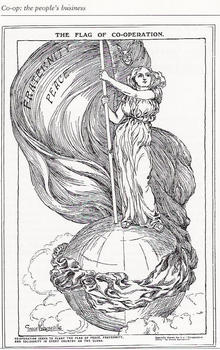Stabler week 6
From digmovements
2. Find art in your movement and blog about it.
Contents |
[edit] *What does art consist of in your movement?
Cooperative movements use art on their web sites and in customer publications. I have mostly seen bright colors, with organic food for the food co-ops. One such source as :
Leeann Lane - Female Emigration and the Cooperative Movement in ... The aims of the cooperative movement were summarized by Plunkett in the slogan ..... William Morris's admiration for the "organic art of the past," in which ... muse.jhu.edu/journals/new_hibernia_review/v008/8.4lane.html - Similar pages
[edit] *Where is it found?
The art is found within the co-op media site and publications, one usually has to search it out. This is a great example of the art in movement of cooperation:
http://www.emmett.ca/bigidea/
[edit] *Who is making it?
If there is no art in your movement, discuss how there could be.
- Make some examples - ie, make a montage image or poster, write a poem, choose some relevant songs.
There could be more advertising for the food co-op in large newspapers and around town that portray cooperative principles.
[edit] Final Tilly questions
Who are the participants in the movement?
People who believe in sharing of resources, people who put other people first, people who believe there is an abundance in the world, enough to go around and to share.
- Organizers – Who are the proponents initiating and guiding the movement? The Dairy, Farm and electric companies.
- Activists – Who are the active followers? The citizens who eat from the co-ops, who drink milk, and who use electricity.
- Authorities – Who or what are the powers the movement targets? FARMERS AND CITIZENS.
- Third parties – Who is in between? As public observers? Allies? “Objects of reform”? CITIZENS, CO-OP MEMBERS, FRAMERS.
more:* Canadian worker co-op movement
* Mondragon Co-operative Corporation * International worker co-op movement * U.S. worker co-op movement * Economic Democracy for the Americas
What are the claims of your movement? (35-36) The principles of the cooperative:
1. Open, voluntary membership. 2. Democratic governance. 3. Limited return on equity. 4. Surplus belongs to members. 5. Education of members and public in cooperative principles. 6. Cooperation between cooperatives.
- Program – What are the movement’s specific political goals?
- Identity – What shared traits or social positions hold the movement’s activists and followers together?
- Standing – What political rights make the movement possible? What material conditions?
Are web technologies creating/transforming your movement? (pp. 97-98) There is definitely more information to learn the benefits of cooperation. But not very much advertising.
- In what ways?
- How do they produce their effects?
- How do online tactics and online forms of organization interact with your movement?
- To what extent and how do recent alterations in your movement result from the changes in technology?”

